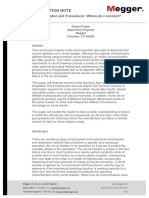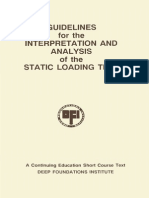SPC4 Bolt Brochure
SPC4 Bolt Brochure
Uploaded by
Doug HeinrichsCopyright:
Available Formats
SPC4 Bolt Brochure
SPC4 Bolt Brochure
Uploaded by
Doug HeinrichsCopyright
Available Formats
Share this document
Did you find this document useful?
Is this content inappropriate?
Copyright:
Available Formats
SPC4 Bolt Brochure
SPC4 Bolt Brochure
Uploaded by
Doug HeinrichsCopyright:
Available Formats
Load Measurement Made Easy
SPC4 load indicating fastener technology allows installation of a bolted assembly with confidence. Users can monitor the clamp load of any SPC4TM bolted joint whether static or dynamic, by attaching an indicator datum disc located on the end of the fastener and reading the value with a user friendly mechanical indicator.
TM
Lamons SPC4 Technology
A fastener is modified by machining a small hole into the head. Minimal modifications to the bolt assures basic bolt design integrity. A gage pin is inserted into the hole and secured at the bottom. A datum disk is fitted on the top of the bolt head and forms a flat surface with the top of the gauge pin when the bolt is unloaded. When the bolt is tightened, it elongates and the gauge pin is drawn into the bolt away from the datum disk surface. This indicator is calibrated to detect the differential space between the indicating pin and datum head. The differential space is translated into a gauge reading that precisely indicates the fasteners loading, related to ultimate yield strength. The benefits of this concept allow the fastener to be loaded many times as long as the stress remains in the elastic range, meeting the criteria of ASTM F2482. An accurate assessment of loading can also be obtained after the joint has been put into service.
Common Bolt Issues
There are two variables in any bolted joint design that continually plague the industry. Achieving accurate preload and maintaining this preload are the most common issues associated with problematic flanges and bolted joints. Some of the better flange tightening procedures that exist incorporate torque as the preferred method for attempting to establish accurate preload. While it can be acknowledged that torque is a reliable indicator of bolt stress, it should be realized that there are a number of factors that heavily impact the accuracy of this tightening method. Torque wrenches must be calibrated regularly. These tools are often fragile and sensitive to loss of accuracy if dropped or handled improperly. Operators often loosely interpret the click of a torque wrench and overturn the fastener. The speed at which the operator turns the wrench will affect accuracy of targeted bolt load. Torque wrenches are often long leverage devices which makes this impractical in compact situations where an operator cannot turn the tool. Friction in the entire joint and all mating surfaces will be the most significant deterrent to accuracy. Friction is not accounted for in the twisting force of torque and will result in greater bolt scatter and inaccuracy. These problems with torque have long been recognized and there have been several solutions offered by bolting and hardware manufacturers to gauge bolt stress more accurately. The more successful technologies measure the change in length of a fastener and compare the length in an unloaded state and to that of a loaded state. Using Hookes Law of elasticity one can accurately relate stress in a fastener with the elongation of that component.
Gauge that easily snaps on and off SPC4 bolt end for accurate load readings
Anchored Indicating Pin
Reading bolt load on SPC4 bolt with gauge
Detail
Integrity of a bolted joint is jeopardized when fasteners lose their tension. This loss of clamping force begins even during assembly due to elastic interactions and joint relaxation. Self-loosening continues when the joint is put in service due to vibrations, temperature changes, shock, etc. The SPC4TM joint allows the end-user to retighten only the bolts or studs that have lost their clamp load, resulting in a tremendous saving of maintenance time, money, and replacement parts.
Lamons SPC4 Load Indicating Fastener
Unloaded Detail
Loaded Detail
Gauge translates variable gap between pin and datum head accurately into bolt stress
Traditional torque method
Mathematically, Hookes law states: F = -kx where x is the displacement of the end of the spring from its equilibrium position (in SI units: m); F is the restoring force exerted by the material (in SI units: N or kgs-2); and k is the force constant (or spring constant) (in SI units: N m-1 or kgs-2). When this holds, the behavior is said to be linear. If shown on a graph, the line should show a direct variation. There is a negative sign on the right hand side of the equation because the restoring force always acts in the opposite direction of the displacement (for example, when a spring is stretched to the left, it pulls back to the right). Relative to Bolting and Fastener materials, Hookes law would be applicable for these materials throughout its elastic range (below their yield strength). This linear relationship described in Hookes law creates a scenario where a user can very accurately monitor bolt extension and directly relate this to the stress in the fastener. Historical methods for measuring this change in length include: Physical measurement of the change in length with a gauge Physical measurements require the ends of the fasteners to be polished and parallel. Any contamination or damage to the end of the measurement surface will cause faulty readings. Compact space restrictions will often limit the use of measurement equipment around piping systems. Ultrasonics utilizes the measurement of the transit time of an ultrasonic signal over the length of the fastener. Ultrasonics require electronic equipment to be taken in the field and records of specific fastener data have to be stored in order to relate initial readings with future readings. Wiring and associating previous records with the correct fastener can be inconvenient and difficult. This equipment is sensitive to temperature changes and must be calibrated often to account for this variable.
A New Dimension to Bolting Technology is Here
For a minimal investment, the SPC4TM offers maximum joint integrity with optimum performance. The ability to monitor stud load after assembly is a key ASTM F2482 feature and something very unique to this SPC4TM technology.
Sealing Global - Servicing Local
US L o c at i o n s
Texas Houston HQ 713-222-0284 409-838-6304 Freeport 979-265-2100 Pennsylvania 610-364-1111 Louisiana 225-292-4250 Luling 985-785-4160 Westlake 337-882-1681 Illinois 815-744-3902 California 925-313-9080
Baton Rouge
Martinez
Beaumont
Rancho Dominguez
310-886-1133 Utah
Salt Lake City
801-532-2338 Washington 360-733-3831
Boothwyn
Joliet
Bellingham
G l o b al L o c at i o n s
Canada 780-461-5557 905-871-0600 519-332-1800 China 0086 512-56720109 The Netherlands 31 0 10-4290388 United Kingdom 01472 250033
Edmonton Ft. Erie Sarnia
Zhangjiagang Rotterdam
Grimsby
Lamons SPC4 Load Indicating Fastener Technology
Martinez, CA Joliet, IL Boothwyn, PA SLC, UT Rancho Dominguez, CA Beaumont, TX Westlake, LA Houston, TX Baton Rouge, LA Luling, LA Freeport, TX
Bellingham, WA
Edmonton
Sarnia Ft. Erie
Grimsby, UK
Rotterdam, The Netherlands
Zhangjiagang, China Hangzhou, China
Lamons Branch Lamons Distributor
Contact Information sales@lamons.com
Physical Measurement of Fastener Ultrasonic Measurement of a Fastener
Technical Information engineering@lamons.com
1- 8 0 0 - 2 3 1- 6 9 0 9
You might also like
- Springs Understanding Hooke S Law Calculation SheetNo ratings yetSprings Understanding Hooke S Law Calculation Sheet4 pages
- Practical Guides to Testing and Commissioning of Mechanical, Electrical and Plumbing (Mep) InstallationsFrom EverandPractical Guides to Testing and Commissioning of Mechanical, Electrical and Plumbing (Mep) Installations4/5 (4)
- UMAT Subroutine Implementation: Michael Wenani NielsenNo ratings yetUMAT Subroutine Implementation: Michael Wenani Nielsen13 pages
- Design Verification of Winch For Offshore Cranes PDFNo ratings yetDesign Verification of Winch For Offshore Cranes PDF4 pages
- Bolt Load Measurement Report - Comparing Different Bolting MethodsNo ratings yetBolt Load Measurement Report - Comparing Different Bolting Methods16 pages
- A Simple Method For Simultaneously Tensi PDFNo ratings yetA Simple Method For Simultaneously Tensi PDF8 pages
- STANDARD TEST METHOD PIT (Pile Integrity Test)No ratings yetSTANDARD TEST METHOD PIT (Pile Integrity Test)5 pages
- Instruction Manual High-Strength Structural Bolting AssembliesNo ratings yetInstruction Manual High-Strength Structural Bolting Assemblies30 pages
- Sensors: A Synthetic Phased Array Surface Acoustic Wave Sensor For Quantifying Bolt TensionNo ratings yetSensors: A Synthetic Phased Array Surface Acoustic Wave Sensor For Quantifying Bolt Tension14 pages
- HFY3-3720-ELE-PD-0002 - 0 OHTL Installation and Test Procedure100% (1)HFY3-3720-ELE-PD-0002 - 0 OHTL Installation and Test Procedure10 pages
- Bearing Life Improvement of Centrifugal Blowers by Vibration AnalysisNo ratings yetBearing Life Improvement of Centrifugal Blowers by Vibration Analysis4 pages
- VD - 68 Design Verification of Winch For Offshore CranesNo ratings yetVD - 68 Design Verification of Winch For Offshore Cranes4 pages
- Section 2 - Participant Manual - What Is TorqueNo ratings yetSection 2 - Participant Manual - What Is Torque30 pages
- Assembly and Tensioning of High Strength Bolts andNo ratings yetAssembly and Tensioning of High Strength Bolts and14 pages
- Assembly and Tensioning of High Strength Bolts and Nuts: Technical Note 62No ratings yetAssembly and Tensioning of High Strength Bolts and Nuts: Technical Note 6212 pages
- ECM-Transformers Guidelines For InstallingNo ratings yetECM-Transformers Guidelines For Installing24 pages
- Strain Measurement MEASUREMENT EXPERIMENT: 1. ObjectNo ratings yetStrain Measurement MEASUREMENT EXPERIMENT: 1. Object7 pages
- Arijit Mandal - 34600723011 - Metrology & InstrumentationNo ratings yetArijit Mandal - 34600723011 - Metrology & Instrumentation14 pages
- Erection Procedures For Medium Voltage Switchgear - EEP PDFNo ratings yetErection Procedures For Medium Voltage Switchgear - EEP PDF5 pages
- 4 - Structural Bolt Tightening Methods ChecklistNo ratings yet4 - Structural Bolt Tightening Methods Checklist6 pages
- Man142 Vibrating Wire Embedment Strain GaugeNo ratings yetMan142 Vibrating Wire Embedment Strain Gauge20 pages
- Installation / Operation / Maintenance Instructions Magnetic Level GaugeNo ratings yetInstallation / Operation / Maintenance Instructions Magnetic Level Gauge6 pages
- Stage 8: Fastener Technology PresentationNo ratings yetStage 8: Fastener Technology Presentation26 pages
- Finite Element Modeling of Cable Hook BoltsNo ratings yetFinite Element Modeling of Cable Hook Bolts12 pages
- Engineering Critical Assessment (ECA) for Offshore Pipeline SystemsFrom EverandEngineering Critical Assessment (ECA) for Offshore Pipeline SystemsNo ratings yet
- Micrometers - Slide Gauges and Calipers - Principles, Construction, Operation and Use of Appliances for Fine Mechanical MeasurementsFrom EverandMicrometers - Slide Gauges and Calipers - Principles, Construction, Operation and Use of Appliances for Fine Mechanical MeasurementsNo ratings yet
- Simrit 08 - Diaphragms (Technical Manual 2007)No ratings yetSimrit 08 - Diaphragms (Technical Manual 2007)30 pages
- Annex B BSMarE Course Specifications For Engineering MaterialsNo ratings yetAnnex B BSMarE Course Specifications For Engineering Materials8 pages
- Physics Notes Class 11 Chapter 9 Mechanical Properties of SolidsNo ratings yetPhysics Notes Class 11 Chapter 9 Mechanical Properties of Solids2 pages
- Vibration Lab 4-Mass Spring System B Lab 4No ratings yetVibration Lab 4-Mass Spring System B Lab 419 pages
- Basic Equations and Plane-Elasticity TheoryNo ratings yetBasic Equations and Plane-Elasticity Theory23 pages
- Static Resistance Bolted Circular Flange JointsNo ratings yetStatic Resistance Bolted Circular Flange Joints9 pages

























































































